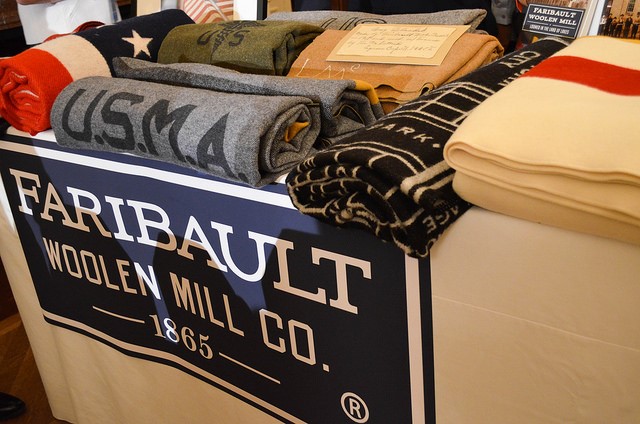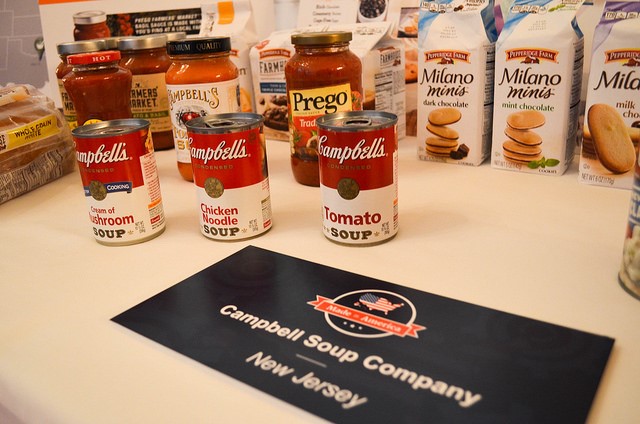
Much like the presidency, Made in America is now leading to division. But it shouldn’t.
Made in America once was a guaranteed thing that brought Americans together.
Way back in 2014, 95 percent of Americans said they have a favorable view of American-made products.
Flash-forward to this week, which President Trump has officially named Made in America Week. American manufacturing companies from every state have been showcased at the White House, and the president is traveling to Norfolk this weekend for the commissioning of the U.S.S. Gerald R. Ford, which was built with American-made steel.
But like everything Trump touches, #MadeinAmericaWeek has seemed to only generate division. The entire Trump clan has been (fairly) criticized for touting Made in America while manufacturing their own product lines abroad. Others have (quite unfairly) said promoting Made in America is merely “catnip” for politicians and doesn’t actually mean anything.
Considering our slogan here at the Alliance for American Manufacturing is “Keep it Made in America,” I think you can probably guess where we land in this debate. But let’s examine why we strongly support Made in America — and why we think you should, too, whether you love or hate the 45th president.
American Manufacturing Matters. A Lot.
There’s an awful lot of talk these days about how the manufacturing sector’s best days are long gone, but that simply runs counter to what is actually going on. As CBS News noted this week, the manufacturing sector is “by far the biggest contributor to the U.S. economy.” In 2016, American factories made $5.3 trillion worth of goods, surpassing every other sector, from real estate to health care to retail and construction.
Manufacturing is also essential to innovation. It accounts for 70 percent of private-sector research and development, and an astounding 90 percent of all new patents. American factories help drive huge technological advancements that transform the world.
We need to continue to make stuff for our economy to grow and thrive.
American Manufacturing Jobs Still Matter, Too.
While the manufacturing sector continues to be the driving force of the U.S. economy, there is also little doubt that the number of American manufacturing jobs have decreased in recent years. Some of that is due to increased productivity — i.e., automation — but most job losses happened because of trade. As the Economic Policy Institute (EPI) has reported, job losses stemming from China’s entry into the World Trade Organization in 2001 are roughly four times as large as losses from growing robot competition.
But despite the “China trade shock” of the 2000s, millions of Americans are still employed in manufacturing — nearly 12.4 million of them as of June 2017. And manufacturing is a job creator — one job in the steel industry creates seven additional jobs in other sectors; 1 in 25 U.S. jobs is tied to the American auto industry.
Manufacturing jobs also tend to pay better. The National Association of Manufacturers reports that the average manufacturing worker earned $81,289 annually in 2015, compared to the average $63,830 for folks in other sectors. For workers without a college degree, manufacturing pays $1.78 per hour more than other sectors, EPI reports.
And while much of the discussion about manufacturing in the Trump era has centered on the white working class, it’s worth noting that factory jobs have also been essential to helping Americans of all backgrounds thrive. My colleague Gerald Taylor authored a 2016 report looking at how African Americans were disproportionally hurt by industrial flight and manufacturing job loss — and how smart policy can help African American workers in the future.
If we want to rebuild and sustain a thriving American middle class, we need to focus on policies that create opportunity and decrease inequality. That includes growing manufacturing jobs, which provide that opportunity for roughly 8.8 percent of the American workforce.
It’s Not Just About Jobs and the Economy, Either
Buying an American-made product is an easy way to support job growth — if every American spent $64 each year on Made in America goods, we’d create an additional 200,000 jobs. But that’s not the only reason to buy Made in America.
For one, there are big environmental benefits to American-made goods. American industrial makers like steel and aluminum companies abide by strict environmental guidelines, which means these companies produce the most efficient product on the planet. The American Iron and Steel Institute reports that the U.S. steel industry has reduced its energy intensity by 32 percent and greenhouse gas emissions intensity by 37 percent since 1990.
Shipping goods across the globe — be it industrial goods or automobiles or consumer items like toys and flatscreen TVs — also leaves a massive global footprint. The marine environment is badly damaged by cargo ships, as they pollute the water and even lead to sound pollution that hurts the ability of ocean species to travel long distances and can cause their death. Whales, manatees and other marine wildlife are also often struck by ships.
Meanwhile, shipping goods across the sea is a significant source of air pollution. Although it’s better than shipping goods via air, cargo shipping still produced 938 million tons of carbon dioxide in 2012.
Price Matters — But It’s Not An Excuse
O.K., so we know the benefits of Made in America — it is the No. 1 driver of our economy, creates opportunity for tens of millions of Americans and is better for the environment. But its detractors often point to price as American manufacturing’s death knell — how can we ever compete when foreign-made goods are less expensive? After all, Americans say they prefer Made in America, but they won’t pay more for it!
Nonsense.
First off, some Made in America companies are not only competing, but they are thriving. Take American Giant, the creator of hoodies, sweatpants and other apparel beloved by the hipster set from Williamsburg to Silver Lake.
Founder Bayard Winthrop launched the company in 2011 after repeatedly being told that nobody could make a sweatshirt in the United States. But with a series of smart, targeted business decisions — American Giant produces a very high-quality product and ramped business up slowly, growing almost exclusively by word-of-mouth — the company is thriving.

It's not just niche companies like American Giant, either. Brooks Brothers makes its line of ties in the United States, along with classic items like its Golden Fleece tailored clothing. New Balance sells several lines of shoes that are manufactured at its facilities in New England. Pyrex makes its popular (and affordable!) line of bakeware and cookware in the United States. Crayola makes its iconic line of crayons in Pennsylvania, along with markers and other items.
Rather than use price differences as a crutch for criticizing Made in America, we should instead be focusing on ways to level the playing field for companies that are already manufacturing in the United States — and find ways to encourage others to do the same. Enacting tax reform, investing in workforce development and innovation and even improving our infrastructure will help American manufacturers compete and thrive.
O.K., Let’s Talk About the Trumps
By far the biggest criticism of the Trump administration’s Made in America Week is the hypocrisy of it. While the president is touting American-made, his own companies have long relied on foreign manufacturing to produce its own stuff, from everything from Trump brand ties to the steel in his buildings. Daughter/adviser Ivanka Trump also has been called out, as her mid-priced fashion line is also produced abroad, allegedly in factories with poor working conditions.
This criticism is fair — but it doesn’t mean the Trumps can’t do something about it.
Look, ever since China entered the WTO, the system has been set up for companies to access cheap labor abroad. American electronics manufacturing all but disappeared in the 2000s, for example, as did U.S. textile manufacturing. The Trumps are hardly alone in relying on foreign labor for their manufacturing needs.
But when President Trump and his team, which includes Ivanka Trump, decided that growing Made in America will be a key part of their efforts in the White House, they opened themselves up to criticism. We don’t expect that the Trump organization will be able to bring back all its manufacturing overnight, but it sure would mean a lot if the company announced at least a handful of products will be made in the United States.
In any case, we all benefit when American manufacturing is strong, and we will all benefit more if we grow the sector — and the jobs that go along with it.
And Made in America will matter long after Trump leaves office. So whether you love this president or hate him, we hope that you will support American manufacturing workers and companies and buy Made in America products when you can.
